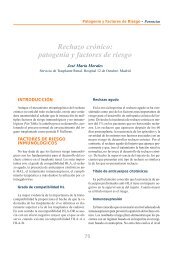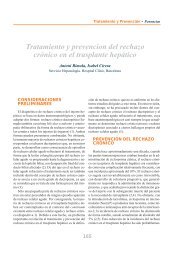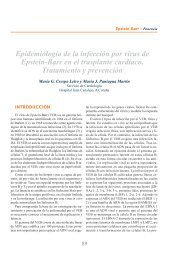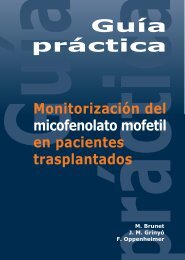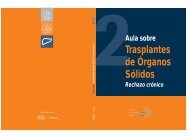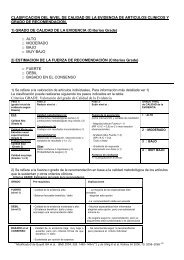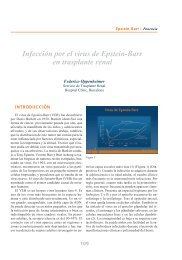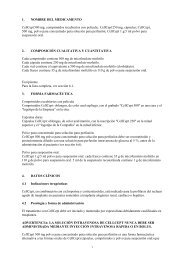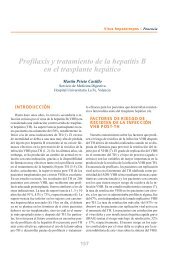Untitled - Roche Trasplantes
Untitled - Roche Trasplantes
Untitled - Roche Trasplantes
Create successful ePaper yourself
Turn your PDF publications into a flip-book with our unique Google optimized e-Paper software.
EARLY DIAGNOSIS OF CHRONIC ALLOGRAFT NEPHROPATHY<br />
BY MEANS OF PROTOCOL BIOPSIES<br />
prevalence was correlated with prior acute rejection episodes, acute nephrotoxicity and<br />
with donor age.<br />
The Westmead series showed what was to some a remarkably high prevalence of CAN,<br />
with almost all grafts affected by CAN grade I by two years, and around 50% with CAN<br />
grade III by ten years (7) (Figure 3).<br />
Figure 3. Prevalence of chronic allograft nephropathy diagnosed<br />
on protocol biopsy by the Banff criteria in 120 simultaneous<br />
kidney pancreas transplant recipients.<br />
Steroid avoidance and use of either sirolimus or mycophenolate mofetil with tacrolimus<br />
lead to 20% grade II and III CAN at only 12 months in both African Americans and non-<br />
African Americans, similar<br />
to the Westmead data<br />
using predominantly cyclosporine<br />
therapy (49).<br />
Moreso et al. showed an<br />
even higher prevalence<br />
of CAN with 175 of 435<br />
(40%) of grafts affected<br />
by six months (29). The<br />
precise estimate of CAN<br />
grade after at different times<br />
after transplantation<br />
varies with the study and<br />
to a certain extent also<br />
with the histologist, but<br />
the important and common<br />
theme is that the level<br />
of pathological impact<br />
is substantially underestimated<br />
by the serum<br />
creatinine and other functional<br />
measures in all studies. It is thus our contention that it is necessary to intervene<br />
early if one is to reduce the level of histological chronic allograft nephropathy.<br />
Utility of diagnosing and detecting CAN early<br />
One could legitimately ask the question: is it worth making the diagnosis of CAN? Is there<br />
a therapeutic utility to making the diagnosis? Is it possible to either reverse or prevent<br />
deterioration in the histology once the diagnosis has been made? These questions are<br />
all predicated on therapeutic nihilism which dictates that once the damage has been done<br />
it cannot be undone. There is some justice in this approach, since sclerosed glomeruli<br />
will not spring back to life and atrophic tubules will not regenerate to normal morphology<br />
and function. The only conclusion that one can make is that therapy designed to halt the<br />
23




